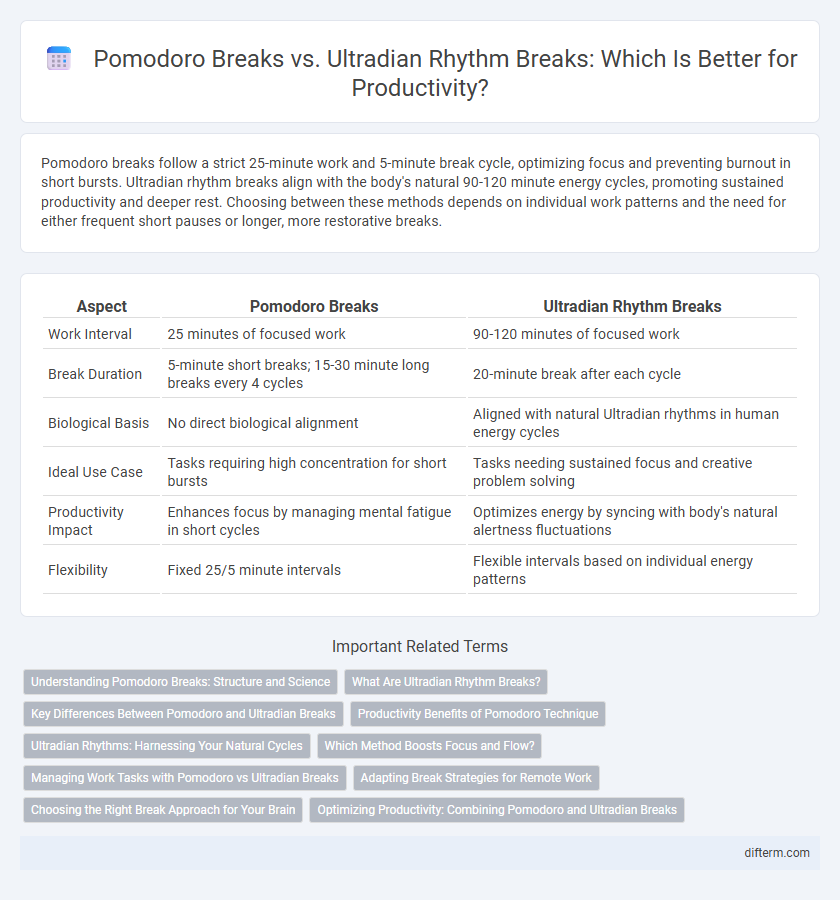Pomodoro breaks follow a strict 25-minute work and 5-minute break cycle, optimizing focus and preventing burnout in short bursts. Ultradian rhythm breaks align with the body's natural 90-120 minute energy cycles, promoting sustained productivity and deeper rest. Choosing between these methods depends on individual work patterns and the need for either frequent short pauses or longer, more restorative breaks.
Table of Comparison
| Aspect | Pomodoro Breaks | Ultradian Rhythm Breaks |
|---|---|---|
| Work Interval | 25 minutes of focused work | 90-120 minutes of focused work |
| Break Duration | 5-minute short breaks; 15-30 minute long breaks every 4 cycles | 20-minute break after each cycle |
| Biological Basis | No direct biological alignment | Aligned with natural Ultradian rhythms in human energy cycles |
| Ideal Use Case | Tasks requiring high concentration for short bursts | Tasks needing sustained focus and creative problem solving |
| Productivity Impact | Enhances focus by managing mental fatigue in short cycles | Optimizes energy by syncing with body's natural alertness fluctuations |
| Flexibility | Fixed 25/5 minute intervals | Flexible intervals based on individual energy patterns |
Understanding Pomodoro Breaks: Structure and Science
Pomodoro breaks follow a structured 25-minute work interval followed by a 5-minute rest, leveraging ultradian rhythms that cycle every 90-120 minutes to optimize cognitive performance and prevent burnout. This technique harnesses focused bursts of productivity aligned with natural attention spans, enhancing task management and reducing mental fatigue. Scientific studies affirm that these frequent short breaks improve concentration and maintain high-quality work output over extended periods.
What Are Ultradian Rhythm Breaks?
Ultradian rhythm breaks align with the body's natural 90-120 minute cycles of high alertness followed by a period of lower energy, optimizing productivity without causing burnout. Unlike Pomodoro breaks, which occur at fixed intervals of 25 minutes, ultradian breaks respond to intrinsic biological signals, promoting sustained focus and mental recovery. Incorporating ultradian rhythm breaks supports cognitive performance by matching work periods to natural physiological rhythms.
Key Differences Between Pomodoro and Ultradian Breaks
Pomodoro breaks follow a fixed 25-minute work interval followed by a 5-minute break, optimizing short bursts of intense focus and frequent rest to prevent burnout. Ultradian rhythm breaks align with the body's natural 90- to 120-minute energy cycles, promoting longer work periods followed by 15- to 20-minute rest to enhance sustained productivity and cognitive recovery. Key differences include the Pomodoro method's strict timing versus the Ultradian approach's flexibility based on natural biological rhythms, impacting overall work endurance and mental clarity.
Productivity Benefits of Pomodoro Technique
The Pomodoro Technique enhances productivity by dividing work into focused intervals, traditionally 25 minutes, followed by short breaks, which prevents mental fatigue and maintains high concentration levels. This method leverages deliberate time management, allowing the brain to reset frequently, thus improving information retention and reducing burnout. Compared to Ultradian rhythm breaks, which align with natural 90-120 minute energy cycles, Pomodoro breaks offer a more structured and scalable approach for tasks requiring sustained focus and frequent pauses.
Ultradian Rhythms: Harnessing Your Natural Cycles
Ultradian rhythms, cycles lasting about 90-120 minutes, align with the body's natural energy and focus fluctuations, offering a scientifically-backed approach to scheduling breaks for enhanced productivity. Unlike the rigid 25-minute Pomodoro intervals, ultradian rhythm breaks adapt to individual physiological signals, promoting sustained concentration and reducing cognitive fatigue. Integrating ultradian breaks into work routines optimizes mental clarity by respecting the body's inherent biological timing, leading to improved workflow and overall efficiency.
Which Method Boosts Focus and Flow?
Pomodoro breaks, structured as 25-minute work intervals followed by 5-minute rests, optimize short-term focus and productivity by leveraging consistent time management cycles. Ultradian rhythm breaks align with the body's natural 90-120 minute energy cycles, allowing deeper, sustained flow states and improved cognitive performance over longer periods. Research indicates ultradian rhythm breaks may better enhance overall focus and flow for tasks requiring extended concentration, while Pomodoro suits tasks needing frequent resets and rapid productivity bursts.
Managing Work Tasks with Pomodoro vs Ultradian Breaks
Managing work tasks using Pomodoro breaks, which typically involve 25 minutes of focused work followed by a 5-minute break, enhances short-term concentration and task completion. In contrast, Ultradian rhythm breaks align with the body's natural 90-120 minute energy cycles, promoting sustained productivity and better cognitive recovery through longer work intervals and extended rest periods. Choosing Pomodoro or Ultradian breaks depends on task complexity and individual energy patterns, optimizing focus and reducing burnout.
Adapting Break Strategies for Remote Work
Adapting break strategies for remote work involves balancing Pomodoro technique intervals with Ultradian rhythm breaks to optimize productivity and mental clarity. Pomodoro breaks, typically every 25 minutes, help maintain short bursts of intense focus, while Ultradian rhythm breaks, occurring every 90-120 minutes, align with natural energy fluctuations in the body, promoting deeper rest and sustained performance. Integrating both methods allows remote workers to customize their schedules based on personal energy patterns and task demands, enhancing overall efficiency and well-being.
Choosing the Right Break Approach for Your Brain
Choosing between Pomodoro breaks and Ultradian rhythm breaks depends on your brain's natural energy cycles and task demands. Pomodoro breaks, typically every 25 minutes, suit tasks requiring intense focus and short recovery, while Ultradian rhythm breaks align with 90-120 minute cycles of peak productivity followed by rest. Tailoring break intervals to your cognitive patterns enhances sustained attention, reduces mental fatigue, and boosts overall productivity.
Optimizing Productivity: Combining Pomodoro and Ultradian Breaks
Optimizing productivity involves strategically integrating Pomodoro breaks with Ultradian rhythm breaks to align work intervals with natural cognitive energy cycles. Pomodoro techniques segment tasks into 25-minute focus periods followed by short breaks, enhancing sustained concentration, while Ultradian rhythms emphasize 90- to 120-minute work phases succeeded by longer restorative breaks. Combining these methods leverages frequent short pauses for immediate mental refreshment and extended breaks for deeper recuperation, resulting in improved task efficiency and reduced burnout.
Pomodoro breaks vs Ultradian rhythm breaks Infographic

 difterm.com
difterm.com